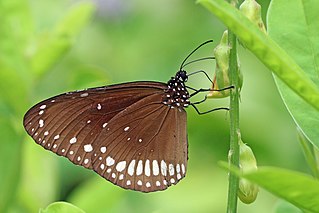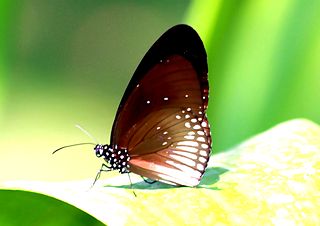
Euploea core, also known as the common crow, is a common butterfly found in South Asia to Australia. In India it is also sometimes referred to as the common Indian crow, and in Australia as the Australian crow. It belongs to the crows and tigers subfamily Danainae.

Tirumala limniace, the blue tiger, is a species of butterfly found in South Asia, and Southeast Asia that belongs to the brush-footed butterfly family, Nymphalidae. More specifically it is part of the crows and tigers or danaid group. This butterfly shows gregarious migratory behaviour in southern India. In some places, it may be found in congregations with Danaus genutia, Tirumala septentrionis, Euploea sylvester, Euploea core, Parantica aglea, and at high elevations, with Parantica nilgiriensis, on Crotalaria.

Hypolimnas bolina, the great eggfly, common eggfly, varied eggfly, or in New Zealand the blue moon butterfly, is a species of nymphalid butterfly found from Madagascar to Asia and Australia.

Euploea mulciber, the striped blue crow, is a butterfly found in India and Southeast Asia that belongs to the crows and tigers, that is, the danaid group of the brush-footed butterflies family.

Euploea doubledayi, the greaterstriped black crow, is a butterfly found in India and South-East Asia that belongs to the crows and tigers, that is, the danaid group of the brush-footed butterflies family.

Euploea sylvester, the double-branded crow, also known as the two-brand crow in Australia, is a butterfly found in South Asia, Southeast Asia and parts of Australia that belongs to the crows and tigers, that is, the danaid group of the brush-footed butterflies family.

Euploea algea, the long branded blue crow, is a butterfly found in India and Southeast Asia that belongs to the crows and tigers, that is, the Danaid group of the brush-footed butterflies family.

Euploea klugii, the brown king crow or king crow, is a butterfly from the family Nymphalidae found in India and Southeast Asia. The species was first described by the entomologist Frederic Moore in 1858.

Euploea midamus, the blue spotted crow, is a butterfly found in India and South-East Asia that belongs to the crows and tigers, that is, the danaid group of the brush-footed butterflies family.

Euploea eunice, commonly called blue-banded king crow, is a species of butterfly that belongs to the Danaid group of the brush-footed butterflies family. It is found in the Indomalayan realm.

The Seychelles crow is a species of nymphalid butterfly in the Danainae subfamily. It is endemic to the Seychelles, where it is only found on the islands of Mahe and Silhouette.

The Mascarene crow is a species of Nymphalidae butterfly in the Danainae subfamily. It is found in Mauritius and Réunion.

Euploea alcathoe, commonly known as the no-brand crow, Eichhorn's crow or striped black crow, is a common butterfly found from India to Borneo, and in the Moluccas, New Guinea and Australia. It belongs to the crows and tigers subfamily of the Nymphalidae.
Euploea desjardinsii is a butterfly in the family Nymphalidae. It is found on Rodrigues and is likely to be extinct.

Euploea goudotii is a butterfly in the family Nymphalidae. It is found on La Reunion.

Euploea modesta, the plain blue crow, is a butterfly in the family Nymphalidae. It was described by Arthur Gardiner Butler in 1866. It is found in the Indomalayan realm and the Australasian realm.

Elymnias malelas, the spotted palmfly, is a butterfly in the family Nymphalidae. It was described by William Chapman Hewitson in 1863. It is found in northern India and Indochina in the Indomalayan realm.
Euploea nechos is a butterfly found in the Solomon Islands that belongs to the danaid group of the brush-footed butterflies family. The species was first described by Mathew in 1887.















